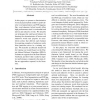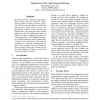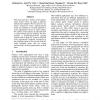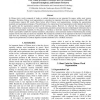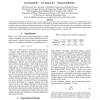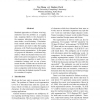100
click to vote
COLING
2010
14 years 7 months ago
2010
We present a theoretical and empirical comparative analysis of the two dominant categories of approaches in Chinese word segmentation: word-based models and character-based models...
113
click to vote
ACL
2009
14 years 10 months ago
2009
In this paper, we present a discriminative word-character hybrid model for joint Chinese word segmentation and POS tagging. Our word-character hybrid model offers high performance...
105
Voted
ACL
2009
14 years 10 months ago
2009
Manually annotated corpora are valuable but scarce resources, yet for many annotation tasks such as treebanking and sequence labeling there exist multiple corpora with different a...
138
click to vote
ACL
2003
15 years 1 months ago
2003
This paper presents a Chinese word segmentation system that uses improved sourcechannel models of Chinese sentence generation. Chinese words are defined as one of the following fo...
113
Voted
ACL
2006
15 years 2 months ago
2006
We proposed a subword-based tagging for Chinese word segmentation to improve the existing character-based tagging. The subword-based tagging was implemented using the maximum entr...
93
Voted
ACL
2006
15 years 2 months ago
2006
This paper presents a discriminative pruning method of n-gram language model for Chinese word segmentation. To reduce the size of the language model that is used in a Chinese word...
ACL
2004
15 years 2 months ago
2004
This paper presents a Chinese word segmentation system which can adapt to different domains and standards. We first present a statistical framework where domain-specific words are...
103
click to vote
LREC
2010
15 years 2 months ago
2010
In Chinese texts, words composed of single or multiple characters are not separated by spaces, unlike most western languages. Therefore Chinese word segmentation is considered an ...
110
click to vote
LREC
2010
15 years 2 months ago
2010
We investigate the impact of input data scale in corpus-based learning using a study style of Zipf's law. In our research, Chinese word segmentation is chosen as the study ca...
104
click to vote
ACL
2007
15 years 2 months ago
2007
Standard approaches to Chinese word segmentation treat the problem as a tagging task, assigning labels to the characters in the sequence indicating whether the character marks a w...

